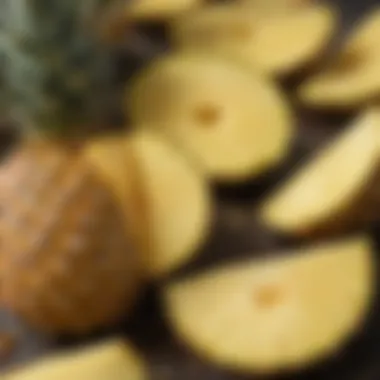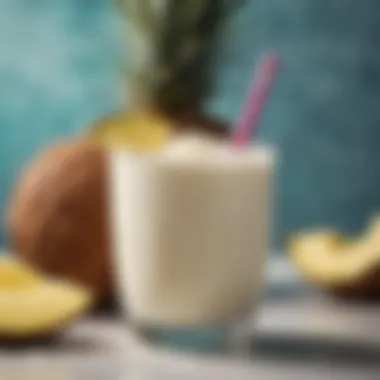Essential Ingredients for a Perfect Piña Colada


Intro
The Piña Colada is a cocktail that evokes images of sandy beaches and sun-drenched holidays. Its combination of pineapple and coconut creates a tropical oasis in a glass. This guide delves into the various elements essential to producing an authentic Piña Colada, from the primary ingredients to the nuances that enhance its flavor and texture.
Understanding the significance of these components not only elevates the drink itself but also enriches the experience for those who savor it. Both novice bartenders and seasoned mixologists can benefit from this comprehensive overview. The next sections reveal the subtle art of crafting a Piña Colada, examining key ingredients that form the backbone of this beloved beverage.
Recipe Overview
Recipe Name and Description
Classic Piña Colada: A delightful blend of pineapple, coconut cream, and white rum, served blended or shaken, often garnished with fresh fruit or a small cocktail umbrella. The Piña Colada achieves a balance between sweetness and acidity, which makes it a refreshingly satisfying drink.
Cuisine Type
Tropical Caribbean: The Piña Colada is rooted in Caribbean culture, where coconut and pineapple are staples. It embodies the carefree spirit of island life and the vibrant flavors of local ingredients.
Ingredients List
Detailed Ingredient Breakdown
A Piña Colada typically includes the following components:
- Pineapple Juice: Freshly squeezed or high-quality bottled juice gives the drink its signature sweetness and acidity.
- Coconut Cream: Provides a rich, creamy texture that complements the fruitiness of the pineapple. This can be found in various brands, such as Coco Lopez or Thai Kitchen.
- White Rum: A key spirit in the mix, offering smoothness without overpowering the other flavors. Brands like Bacardi or Havana Club are common choices.
- Ice: Crucial for achieving the right consistency whether blended or shaken.
- Garnishes: Common garnishes include a slice of fresh pineapple, maraschino cherries, or a sprig of mint for visual appeal.
Substitutions for Dietary Needs
For those with specific dietary preferences or restrictions, the following substitutions can be useful:
- Use coconut milk instead of coconut cream for a lighter version.
- Opt for agave syrup or honey in place of traditional sweeteners if aiming for a natural alternative.
- For a non-alcoholic variation, simply omit the rum and add extra fruit juice or soda for a refreshing mocktail.
Remember, the key to a perfect Piña Colada lies in the quality of ingredients. Opt for fresh and high-quality products to ensure the best flavor profile.
Prologue to Piña Colada Ingredients
The Piña Colada is not just a drink; it is an emblem of tropical relaxation, an experience encapsulated in its sweet and creamy texture. Understanding its essential ingredients is crucial for anyone looking to craft this classic cocktail. Knowledge of each component enhances the drink's overall quality, allowing both novice and experienced mixologists to personalize and perfect their concoctions. This section highlights the significance of each ingredient in achieving the desired flavor profile and texture, laying a foundation for creating an authentic Piña Colada.
Historical Context
The origins of the Piña Colada are somewhat murky, often attributed to several claimants from Puerto Rico. Some stories trace its roots back to the 19th century when sailors mixed rum with coconut and pineapple. Others point to the 1950s, when the drink gained popularity in bars across the region. Despite the uncertainty, one fact remains clear: the Piña Colada has become a beloved symbol of tropical paradises, offering a taste of the island lifestyle. Its rise coincides with the advent of tourism in the Caribbean, where it became a staple in beachside establishments. The development of the blended cocktail marked a significant point in the craft of mixology, contributing to the drink's enduring legacy.
Cultural Significance
The Piña Colada transcends mere beverage status; it evokes memories of sun-soaked beaches and festive gatherings. Culturally, it represents escapism, encapsulating the essence of island life. This cocktail has been popularized through music, literature, and films, further embedding it in popular culture. For many, sipping a Piña Colada signifies a moment of leisure, a break from daily routines. Its flavors have become synonymous with vacations, making it a global favorite among food lovers.
Understanding the historical and cultural contexts of the Piña Colada deepens our appreciation for its ingredients. Each sip not only delights the palate but also connects us to a rich narrative of tradition and celebration.
Core Ingredients


The core ingredients of a Piña Colada form the foundation of its unique flavor and texture. Each element plays a significant role in achieving the perfect balance, ultimately affecting the drink’s overall character and appeal. Understanding these core components is vital for anyone looking to recreate this classic cocktail accurately. Ingredients like pineapple, coconut cream, white rum, and lime juice will cater not just to taste, but also to the mouthfeel and sweetness, making them essential in cocktail crafting.
Pineapple
Varieties of Pineapple
When selecting pineapple for a Piña Colada, the variety chosen can significantly influence the flavor. Common types used include the Queen and the Smooth Cayenne. The Queen pineapple is known for its sweetness and aromatic properties. Its rich flavor profile enhances the drink. The Smooth Cayenne offers a slightly less sweet but very juicy alternative.
The decision here should focus on the taste preference. Overall, fresh varieties stand out as they provide a bold and vibrant flavor. However, this preference also depends on availability and seasonality.
Fresh vs. Canned Pineapple
In the quest for the ideal Piña Colada, whether to use fresh or canned pineapple becomes an important consideration. Fresh pineapple boasts a vibrant taste and retains more nutrients. It is often regarded as the superior option due to its delightful aroma and crunch.
On the other hand, canned pineapple provides convenience. It is ready to use and can maintain sweetness. The syrup in canned options, however, may add unwanted sugar, which some drinkers might prefer to avoid. Thus, while fresh pineapple is usually favoured for authenticity, canned pineapple can be a practical choice.
Coconut Cream
Types of Coconut Cream
Coconut cream varies by brand and preparation method, affecting the overall taste and texture of the Piña Colada. Some popular types include heavy coconut cream, which is rich and flavorful, and light coconut cream, which is less thick. Heavy coconut cream adds a luscious mouthfeel and richness that enhances the cocktail.
Moreover, using pure coconut cream without additives will yield the best results. Ensure that the choice is creamy without excessive preservatives to maintain the drink’s integrity.
Coconut Milk Comparison
Coconut milk is sometimes compared to coconut cream as a lighter alternative. It offers a thinner consistency and less fat. However, while it brings a unique flavor, coconut milk may not deliver the same creaminess that is fundamental for a good Piña Colada.
Many enthusiasts recommend sticking with coconut cream for that classic texture. Coconut milk can work, but it may alter the intended richness of the beverage.
White Rum
Rum Varieties
White rum comes in different varieties, which can affect flavor significantly. Brands like Bacardi and Don Q are popular choices among mixologists. Light rums are often milder and contribute a subtle sweetness, making them suitable for tropical cocktails.
Choosing a good white rum is crucial. Different rums showcase various flavor notes, from light and fruity to richer and spicier profiles, enabling customization of the cocktail.
Impact of Rum Quality
The quality of rum can deeply affect not only the taste but also the overall experience of the Piña Colada. Higher-quality rums tend to have a smoother finish and more complex flavors. While less expensive rums can work in a pinch, they may impart harsh alcohol flavors that can clash with the tropical ingredients.
Skilled drinkers can discern the nuances of flavors. Thus, investing in a quality rum enhances the overall quality of the drink, leading to a more enjoyable experience.
Lime Juice
Fresh vs. Bottled Lime Juice


Lime juice is another critical component that brings acidity and brightness to the Piña Colada. Fresh lime juice is preferred for its tartness and freshness. It provides a vibrant contrast to the sweetness of coconut and pineapple.
Bottled lime juice can be convenient but often lacks the purity of flavor found in fresh juice. While bottled options can work in emergencies, they usually involve preservatives that can alter the drink’s character.
Importance of Lime Juice
Lime juice is essential not just for taste, but for balance. The acidity of lime cuts through the creaminess of coconut cream and complements the sweetness of pineapple. This balance helps to elevate the cocktail into a well-rounded drink.
It is worth noting that adding the right amount can also enhance aroma, leading to a refreshing sensory experience. Therefore, using fresh lime juice is highly recommended for the best flavor in a Piña Colada.
Additional Ingredients
In the realm of crafting the perfect Piña Colada, additional ingredients play a subtle yet pivotal role. These elements enhance the drink's complexity, introduce layers of flavor, and contribute to the desired consistency. While the core ingredients like pineapple, coconut cream, and white rum are essential, the right additional ingredients can elevate the experience significantly. Understanding the nuances of these components is crucial for any mixologist or enthusiast aiming to create an authentic tropical beverage.
Simple Syrup
How to Make Simple Syrup
Simple syrup is an essential ingredient in many cocktails, including the Piña Colada. It is made by dissolving equal parts of sugar and water, usually by heating the mixture. This method allows for easy integration into drinks. The key characteristic of simple syrup is its smooth sweetness, which contrasts nicely with the tartness of lime juice.
Using simple syrup is a beneficial choice as it adds sweetness without the grit that granulated sugar might impart. One unique feature of simple syrup is that it can be flavored with various herbs or fruits, offering versatility for mixologists. However, one disadvantage is its high sugar content, which might not align well with readers seeking healthier alternatives.
Alternatives to Simple Syrup
For those looking to deviate from traditional simple syrup, several alternatives exist. Agave nectar, for example, offers a similar sweetness with a distinct flavor and lower glycemic index. Another option is to use honey, which adds a unique taste but may slightly alter the overall flavor balance of the Piña Colada.
These alternatives can provide a more complex flavor profile, appealing to food lovers seeking variety. However, their unique characteristics could overwhelm the delicate balance required in a classic Piña Colada. It’s important to test and adjust the quantity when substituting.
Ice
Types of Ice for Blending
The type of ice used can greatly influence the texture of a Piña Colada. There are mainly two types: cubed ice and crushed ice. Cubed ice produces a thicker and icier texture, while crushed ice creates a smoother, slush-like consistency, which is often preferred for this tropical drink. The choice of ice contributes to the overall presentation and mouthfeel.
Using crushed ice is typically a popular choice because it blends easily and creates a refreshing sensation. However, one must be cautious of over-blending as it can lead to a watery drink, overwhelming the other flavors.
Ice Ratios
Getting the right ice ratio is crucial for achieving the desired consistency in your drink. A well-balanced ratio between ice and liquid ensures that the cocktail remains refreshing without becoming overly diluted. The general guideline is to use a 2:1 ratio of ice to liquid when making a Piña Colada.
This ratio is beneficial as it provides a balanced flavor release while keeping the drink chilled. An incorrect ratio can lead to inconsistencies in texture and flavor, making it essential for anyone preparing this beverage to pay attention to the specifics of their ice measurement.
Garnishes and Presentation
Garnishes and presentation play a crucial role in the enjoyment of a Piña Colada. They add visual appeal, enhance the overall drinking experience, and can provide a hint of flavor that complements the primary ingredients. Thoughtful garnishing extends beyond mere aesthetics; it can elevate the drink to a more sophisticated level. Considering the right garnishes and glassware options can significantly influence how the cocktail is perceived and enjoyed. Mentioning the importance of a well-presented drink helps set expectations and raises the enjoyment of your Piña Colada.
Traditional Garnishes


Pineapple Wedge
The pineapple wedge is a staple garnish for any classic Piña Colada. Its bright yellow color and tropical scent enhance the visual appeal of the cocktail. This garnish contributes both to the presentation and the experience, as it signifies freshness and the essence of the primary ingredient—pineapple. The key characteristic of a pineapple wedge is its juicy texture, which can also inspire a refreshing bite in between sips.
Using a pineapple wedge is popular due to its recognition and association with tropical drinks. It evokes feelings of relaxation, often reminding drinkers of beach settings. However, it does have a unique feature: the possibility of attracting a few insects if left unattended outdoors. This minor drawback can be managed with careful placement or by serving indoors.
Maraschino Cherry
The Maraschino cherry adds a splash of color to the Piña Colada. This garnish is often placed on top of the drink, creating a classic look that many associate with cocktails. Its vibrant red hue contrasts nicely with the creamy, yellow of the cocktail. The candy-like sweetness of the cherry can also serve as a nice counterpoint to the tropical flavors.
One important aspect of the Maraschino cherry is its convenience. It requires no preparation and is readily available. This makes it a beneficial choice for bars and home mixologists alike. Despite this convenience, some may find that the overly sweet taste does not always harmonize well with the other flavors in the drink. Balancing its sweetness with more tart elements can be a consideration.
Glassware Options
Classic Hurricane Glass
The classic hurricane glass is synonymous with tropical cocktails, including the Piña Colada. Its unique shape allows for generous portions of ice and liquid, enhancing the sensory experience. The wide top creates an opportunity for ample garnishing, while its curved base suggests a flow and movement that adds to the overall appeal.
This glass is a beneficial choice due to its visual impact. It distinctly indicates that the drink being served is special. However, it can be cumbersome for some due to its fragility and size, which may pose a challenge in busy settings.
Alternative Serving Ideas
Considering alternative serving options can also bring a unique touch to the Piña Colada experience. Options like mason jars or coconut shells can infuse a rustic, island vibe into the presentation. These alternatives may highlight creativity and make the drink feel more personalized.
The high characteristic of using unconventional glassware is its ability to evoke feelings of originality and fun, appealing to those looking for something different. However, be mindful of practicality; certain alternatives may not retain the cold temperature as effectively as the hurricane glass.
Optimal presentation enhances both flavor experience and enjoyment.
By thoughtfully choosing your garnishes and glassware, the overall experience of enjoying a Piña Colada can be greatly improved, making each sip a delightful moment.
End
The conclusion of this article serves as a crucial point for summing up the important aspects of crafting the perfect Piña Colada. It reinforces the role each ingredient plays in achieving the desired flavor and texture. Understanding this topic allows both novice and expert mixologists to revisit classic recipes or explore new variations that delight the palate.
Revisiting the Classics
Revisiting the classics is an essential practice in cocktail artistry. The traditional Piña Colada, with its rich blend of pineapple, coconut cream, white rum, and lime juice, encapsulates the essence of tropical indulgence. This blend of ingredients became a staple not just out of taste but also for its harmonious balance. The original recipes remind us of the foundational elements that make any cocktail enjoyable. As we navigate modern variations, honoring these classic proportions provides a benchmark.
Exploring Variations
Exploring variations introduces new facets to the traditional Piña Colada. The possibilities here expand the drink into various dimensions while keeping it fundamentally relatable to its origins. By experimenting, one can discover unique flavors that cater to diverse tastes and preferences.
Infused Piña Coladas
Infused Piña Coladas offer a unique twist to the traditional beverage. By incorporating additional flavors such as herbs, spices, or even teas, these cocktails can provide a refreshing yet familiar experience. The key characteristic lies in their ability to customize and personalize each sip, making it a popular choice among cocktail enthusiasts.
This variation not only amplifies the drink's complexity but also enhances its appeal for adventurous drinkers. One possible downside is that not all infusions will harmonize well with the established ingredients, requiring experimentation to find the right balance. Nevertheless, infused Piña Coladas are versatile and contribute significantly to the drink's overall allure.
Fruit-Specific Variants
Fruit-specific variants elevate the Piña Colada beyond its typical ingredients. By introducing other fruits such as mango, passion fruit, or berries, these versions add dimension while still preserving the tropical vibe. The distinctive feature of these variants is the ability to cater to regional fruit availability, encouraging creativity based on the season.
This approach makes fruit-specific variants not only beneficial but also practical, offering freshness and different flavor profiles. It is important to consider the balance of sweetness and acidity with these alternatives to avoid overwhelming the drink. Embracing various fruits keeps the essence of the Piña Colada alive while expanding its reach to various sensibilities.
In summary, the conclusion pulls together the significant elements discussed in the article to emphasize their role in enhancing the Piña Colada experience. With an appreciation for both classic and innovative takes, one can enjoy a deeper exploration of this iconic cocktail.















